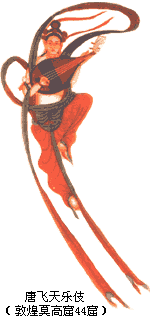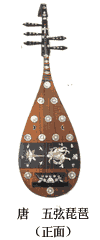The so-called Pipa in history does not refer only to the instrument that is shaped like a pear with a sound box and a neck, rather to a number of similar instruments like “Liǔ Qín”, “Yùe Qín” and “Ruǎn”, which are all Pipa type instruments. The instrument was named by the way the right hand is playing, the plucking forward is called “Pi” and backward is called “Pa”.
 The first Pipa appeared in Qin and Han Periods, at that time its neck was straight; later when the Silk Road was opened, a crooked neck type of Pipa was brought in from Persia.
The first Pipa appeared in Qin and Han Periods, at that time its neck was straight; later when the Silk Road was opened, a crooked neck type of Pipa was brought in from Persia.
During Sui and Tang Dynasties Pipa became one of the most important music instrument, that can be verified by the fresco at Dunhuang Caves as shown in the picture above. During this period, Cao Miaoda was the most outstanding Pipa player, as a matter of fact, his grand-father, father and sister were all playing masters. It is said that one day when he was playing Pipa in the court for the Northern Qi Emperor, while the beautiful and clear sound of his Pipa was blended with the smoke from incense burners, the emperor and minister forgot themselves in the music. When he finished playing the Emperor exclaimed, “Superb! Superb! I shall make you a king!” Hearing this, all the ministers were surprised and it took Cao a while to come to his sense and thanked the emperor. Some people say Cao was the only musician who was made a king; others said that he should thank his sister who was a concubine of the emperor. Cao Miaoda was appointed an official in charge of music in the imperial court of Sui and a tutor teaching Pipa playing in the imperial band.
During the Tang Dynasty, many famous players emerged. Pipa played a key role in Ming and Qing Periods when big sets of music were staged.
A celestial musician playing Pipa, as in the Dunhuang frescoes. Tang 4-string Pipa, now being kept in Japan.


Types of Pipa
1, 5-String Pipa: It was brought into China from central and west Asia via India; for 500 years from the Southern-Northern Dyansties to the end of Tang Dynasty,
 |
 |
|
5-string Pipa of Tang (front) |
5-string Pipa of Tang (back) |
5-string Pipa was the main instrument in playing court music. We can find detailed descriptions of such Pipa in poems written by famous Tang poets. In 756, a 5-string Pipa made of red sandalwood found its way into Japan, it is now being kept at Todaiji Temple in Nara. Because of the delicacy of workmanship, it has been regarded as a precious article among world artistic treasure. When it came to the Song Dynasty, 5-string Pipa was replaced by 4-string Pipa.
2, Pipa for Southern Lores: It was used to present folk lores and especially those of “southern lores of Fujian”. When playing such lores, the Pipa is held horizontally in the arms instead of being vertical as during the Tang Dynasty and before. So, it is also referred to as “horizontally held Pipa”.
This type of Pipa was very popular in southern Fujian and Taiwan, being the main instrument in a band, it played a leading role. It was very often used together with southern lore vertical flute (Xiāo) to play melodies and with its clear and pleasing sound, it gave out a strong local flavor. It was usually 93-104 cm long, its head was shaped like a phoenix with a crooked neck and the sound box looked like a pear.
There are now other kinds of Pipa such as “Sounding Pa” with a thinner back board, “Moon Pa”, “High Pitch Pipa” and electronic Pipa.
Structure of Pipa

The Effect of Pipa
Its sound can go very far with little attenuation; its sound in the alt range is bright and rigorous, in the alto range is soft and lubricating and in the bass range is pure and thick.
Famous Pipa Pieces
|
《Vertical Flute (Xiao) and Drum at Sunset》, one of the representative Pipa scores. It was changed into a string and bamboo pipe score in the 20s of the last century and renamed 《Spring River and Flower under Moonlight》. The title in Chinese is 《夕阳箫鼓—Xi Yang Xiao Gu》。 |
|
《Sunny Spring and White Snow》composed by Shi Kuang, the well-known musician of the State of Jin in the Spring and Autumn Period, we mentioned him in the foregoing. The title suggests that the winter is over and the spring is coming, everything on earth is revived and going to prosper. The title is adopted from 《The Songs of Chu》. Chu was a state in the Warring States period. The King of Chu one day asked Song Yu, a famous poet of Chu, why he had not much good words about the poet. The poet answered that when some one was singing 《Baren at Xiali》in the capital, because this was a pop song, you would hear those who could sing together with him were in thousands, and when a person was singing 《Yáng ā xiè lù》, which was less popular, those who could sing together with him were in hundreds, and when a person was singing 《Sunny Spring and White Snow》, which was much less popular, those who could sing together with him were in a few dozen, and if a person sang a more difficult one, whose who could sing together with him were only two or three. So, the conclusion: the more elegant and complex the song, the fewer the people who could echo. And 《Sunny Spring and White Snow 》 was such an example.
|
|
《“Green Lotus” in the Conservatory》,a big set of Pipa music, which was edited by Li Fangyuan in 1895 on basis of 4 pieces from 《Authentic Notations of Southern and Northern Schools of Pipa Playing》, the first formally printed Pipa scores in China, compiled in 1818 by Hua Qiuping(1787-1859), a well known Qing Dynasty Pipa musician. |
|
《Ambush from Ten Sides》is a traditional and widely spread Pipa music, the earlist version was in Hua Qiuping’s work mentioned above. The piece depicts a war at Gaixia, in 202 B.C. between Liu Bang and Xiang Yu. Han troops headed by Liu Bang used the tactic of ambushing from ten sides and destroyed the Western Chu troops headed by Xiang Yu, who cut his own throat by the side of Wujiang River after he lost the battle. |
|
《Autumn Moon over the Han Palace》, it depicts the life of palace maids in the Han Imperial Palace and their sorrowful, pathetic feeling and their helplessness and loneliness. |
|
《Lord Xiang Takes Off His Armor》, it is a big set of Pipa music, also depicts the battle at Gaixia, but unlike 《Ambush from Ten Sides》, its hero is Lord Xiang Yu instead of Liu Bang. That’s why it sounds depressing, solemn and stirring. Lord Xiang was deflated after he lost the battle, his concubine, Bie Ji thus cut her throat and died for him. The music showed sympathy to this historic figure. |
|
《Snow on Pine》, a famous Pipa piece, which sings praise of the lofty attributes of pine and cypress trees that stand high amidst snow storm. This piece was included into the 《The Ancient Tones》compiled by the Chongming school of Pipa playing in 1916. |
|
《Sands Washed Away by Big Waves》composed by morden composer Ah Bing (1893-1950), the piece shows the composer’s attitude towards life and his emotional sigh over injustice in society. |
|
《Zhaojun Left the Border》portrays how a Han Dynasty palace maid was married to a tribe head of the Hun. The Hun was splitted into 5 parts during the reign of Emperor Xuan of Han. Huhanxie, head of one part of the 5 was friendly to Han Dynasty. He came to the capital of Han Dynasty to request a marriage with a princess. At this time, Emperor Xuan had passed away, and Yuan took over the throne, he agreed to this request and decided to choose one girl from among the maids and marry her as a princess to Huhanxie. However, most maids didn’t wish to go so far to the Hun, but Wang Zhaojun groomed herself. So, Huhanxie and Zhaojun got married in the Han capital on an auspicious day. Huhanxie was extremely satisfied seeing his wife so young and beautiful. By the time they said good-bye to Emperor Yuan, the Emperor found out Zhaojun was extraordinarily beautiful. He wished he could keep her in the palace, but it was too late. Emperor Yuan was very angry with himself, how come he let such a beaty go with the Hun tribe head. He asked for the portrait of Zhaojun, which was done when the maid was brought into the palace, the portrait was not how Zhaojun looked like. When the maids first came to the palace, the emperor only looked at portraits, not the maids themselves. Most maids bribed the painters, but Zhaojun didn’t. So the painter did not paint how she really looked like. Learning this, the emperor was irritated and punished the painter. Zhaojun slowly got used to the life in the Hun and did her best to spread Han culture to the locals. Because of her efforts, Han and the Hun were on good terms for 60 years. After her death, she was burried at Mount Daqing and was treated like a deity there. Ah Bing, the composer, described Zhaojun’s changing feelings when she was crossing the border and revealed his own reflection on this historical event. |
